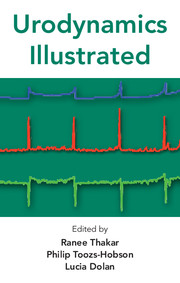Book contents
- Frontmatter
- Contents
- About the authors
- Acknowledgements
- Glossary and abbreviations
- Preface
- 1 Introduction
- 2 Setting up the equipment
- 3 Flow rate testing
- 4 Cystometry
- 5 Videocystourethrography
- 6 Ambulatory urodynamic monitoring
- 7 Urodynamic artefacts
- 8 Assessment of urethral function
- 9 Bladder diaries
- 10 Pad testing
- 11 Pre-test assessment using questionnaires
- 12 Ultrasound as a tool in urodynamics
- Index
8 - Assessment of urethral function
Published online by Cambridge University Press: 05 February 2014
- Frontmatter
- Contents
- About the authors
- Acknowledgements
- Glossary and abbreviations
- Preface
- 1 Introduction
- 2 Setting up the equipment
- 3 Flow rate testing
- 4 Cystometry
- 5 Videocystourethrography
- 6 Ambulatory urodynamic monitoring
- 7 Urodynamic artefacts
- 8 Assessment of urethral function
- 9 Bladder diaries
- 10 Pad testing
- 11 Pre-test assessment using questionnaires
- 12 Ultrasound as a tool in urodynamics
- Index
Summary
Introduction
Many tests of urethral function have been proposed and the International Continence Society (ICS) has suggested standardisation of the performance of some of these studies and has defined parameters for measurements. Components of the urethral continence mechanism (Figure 8.1) are the submucosal vasculature, the urethral smooth muscle, the urethral striated sphincter, the bladder neck and the urethral supports. Failure of one or more of these structures can result in incontinence.
Urethral function tests during filling cystometry
Two tests may be included to assess urethral function specifically during filling cystometry:
□ vesical or detrusor leak-point pressure estimation
□ abdominal leak-point pressure (ALPP).
Vesical or detrusor leak-point pressure
Vesical or detrusor leak-point pressure is recorded as the detrusor pressure at the instance of leakage and is considered to be an indirect measure of urethral resistance.
ALPP
ALPP measures the vesical pressure at which leakage occurs during gradual increase in intra-abdominal pressure in the absence of detrusor overactivity. Patients are instructed to produce a graded Valsalva, thereby increasing intra-abdominal pressure while in the upright position at a bladder volume of 250 ml and after reduction of pelvic organ prolapse.
Urethral function during voiding cystometry
Tests of urethral function during voiding cystometry measure the relationship between pressure in the bladder and urine flow rate. Increased detrusor pressure and synchronous, reduced urine flow rates may indicate ‘abnormal urethral function’. This may be caused by anatomical abnormalities such as a urethral stricture or urethral over activity.
Keywords
- Type
- Chapter
- Information
- Urodynamics Illustrated , pp. 91 - 98Publisher: Cambridge University PressPrint publication year: 2011



